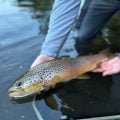Gear Review: Simms G4Z Wader
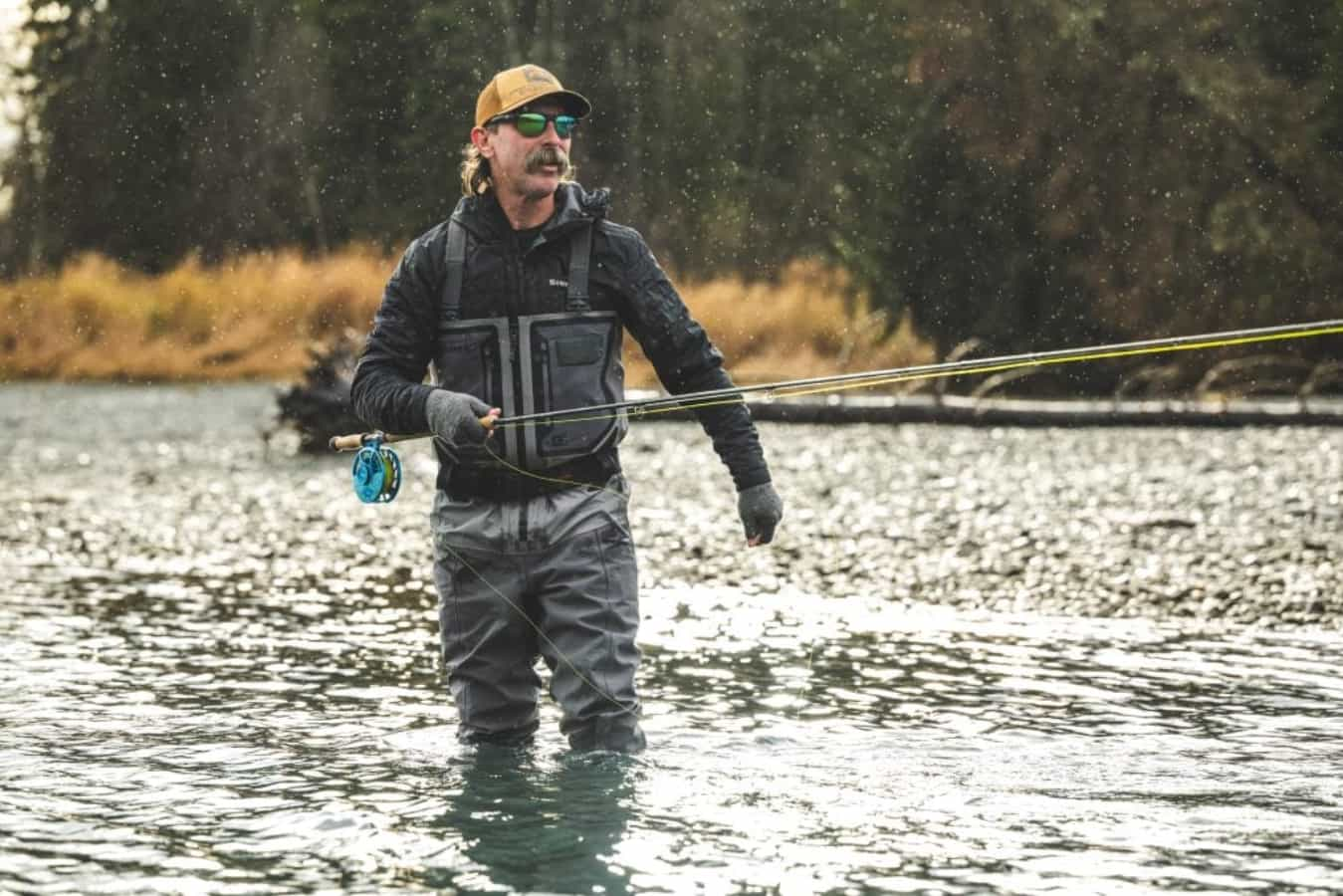 Simms’ latest and greatest wader is truly an impressive piece of gear. It’s accompanied by an equally impressive price tag—$999.95.
Simms’ latest and greatest wader is truly an impressive piece of gear. It’s accompanied by an equally impressive price tag—$999.95.
The way I see my role as a gear reviewer isn’t to tell you to go buy something (that job belongs to the marketing department). My role is to cut through the marketing fluff, put a product through the wringer in real-life applications, and give you an honest assessment of how it performs. Finally, part of my job is to tell you if I think a certain product is worth its asking price.
That’s why I opened this review with the price tag for the Simms G4Z. That asking price will play a huge role in whether an angler buys these waders.
What I’ll quickly say,before getting into the details of the G4Z, is that this wader is the most impressive Simms wader I’ve ever used. I had an older pair of the G4s, back when Simms made those waders with a 5-layer Gore-Tex fabric, and I’d never loved a Simms product more than those. The new G4Z, however, is a substantial improvement over the previous generation, and is easily the most comfortable, functional Simms wader I’ve ever worn.
Now, let’s dig into exactly why I came to that conclusion.
4-Layer Construction
Simms built the G4Z with the same 4-layer Gore-Tex construction they’ve utilized since 2019. Previously, Simms built their waders with a 5-layer Gore-Tex fabric. (A quick note on the layer construction: I’m referring specifically to the lower layers of the wader. Both the G4 and G3 lines utilize a 3-layer upper and a 4-layer lower.)
Why would you ditch a layer of fabric when the whole point of building a wader like the G4Z is to offer the ultimate in your brand’s durability? Well, Simms found that they were able to build a 4-layer lower that’s just as breathable and durable as a 5-layer while also being lighter.
The obvious question to ask here is about durability. Will a 4-layer fabric package live up to the abuse we put our waders through?
“Logically, you’d think 5 layer would be more durable than 4, but through our lab testing, that’s not the case,” John Frazier, PR Manager for Simms, said. “The 4-layer is more flexible, moves better with the angler, less rigid.”
We also have about five years of data on this 4-layer fabric package, and according to Simms, they’re seeing fewer fabric failures. Whether you believe Simms’ claim is immaterial because if the company was seeing more problems with this fabric package it stands to reason Simms would’ve gone back to a 5-layer. If the 4-layer fabric wasn’t durable enough anglers would let the company hear it, and Simms would take a financial hit through increased warranty claims.
In my own time with the G4Z I’ve been pleasantly surprised at how durable the 4-layer fabric feels. Over about four months of solid fishing I’ve yet to see any serious wear or indications that the fabric might be failing in some way.
Of course, the fabric package is only part of a wader’s durability, which leads us to the next aspect of the G4Z we need to examine.
Fit
Over the past two years I’ve had the chance to talk in-depth with technical apparel designers. One of the many things I’ve learned from these conversations is just how important “fit” is to a garment’s durability.
“Fit is the most important part of durability,” John Frazier, Marketing Director for Simms, told me.
He’s completely right. Through my own observations and conversations with wader manufacturers over the past few years, the biggest trend hasn’t been finding a bomb-proof fabric or seam technology. Instead, wader design has focused on improving range-of-motion and fit. This holds true for all the big wader companies, and it’s held true in my own anecdotal experience as well.
A half-decade ago, I reviewed a pair of waders from a prominent company. The waders never fit right, and within a few months the seams on the insides of the legs had busted. Those seams were under so much stress (and in near-constant contact with each other) not through some failure of manufacturing, but because they never fit me correctly. With the exception of the waders that I’ve introduced to barbed-wire fences, almost all of the leaks I’ve had in waders over the past decade were directly related to problems with how they fit.
Now, let’s circle back to the thinner, lighter 4-layer fabric package Simms uses on the G4Z. That fabric package has been reworked with new patterns (the way the fabric is laid out before its sewn or welded together) to create a wader that fits the angler better, and increases range-of-motion. By ensuring a better fit, Simms is able to reduce wear and tear on the fabric, which helps the fabric last longer.
The fit was the first thing I noticed about the G4Zs when I put them on. I have a full range of motion for scrambling over boulders, running to help net a buddy’s fish, or a long hike to a nice fishing spot. These waders certainly move with me better than any iteration of Simms waders I’ve used before.
The G4Z comes in 19 standard sizes, so chances are you’ll find one that fits you perfectly.
“19 standard sizes, that’s a testament to how much we do care about the fit,” Frazier said. “It’s probably not the most cost-effective way to do things, but it’s important.”
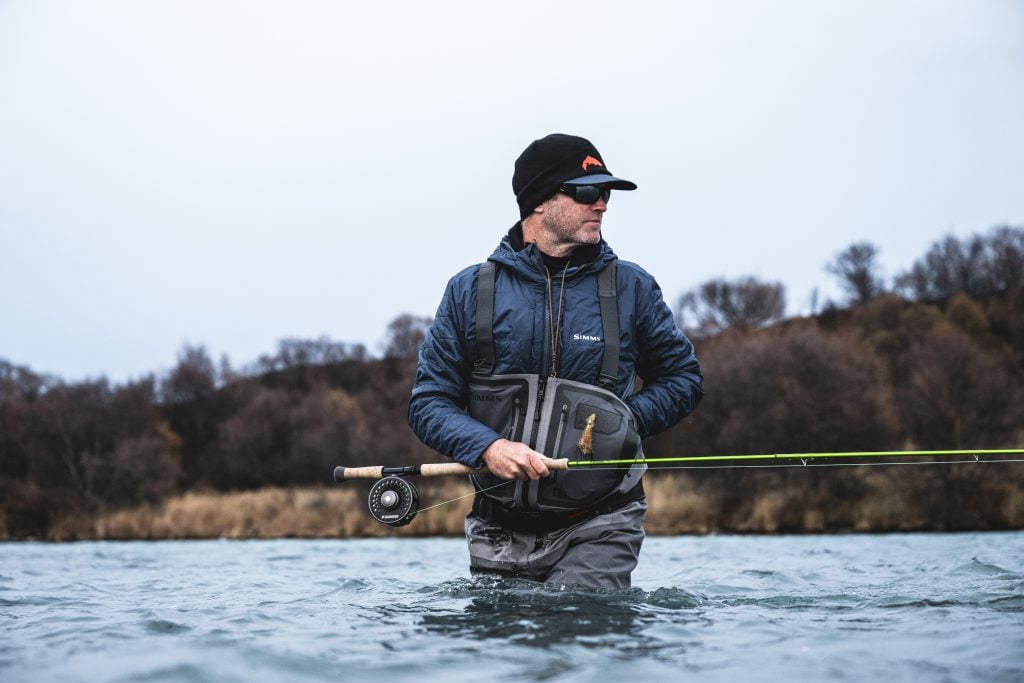
Improved Zipper
The zipper is the main star of the G4Z, and Simms spent considerable time reworking it.
Previous iterations of zippered waders at Simms required 24 layers of fabric to be sewn and welded to keep the zipper in place. That many layers of fabric resulted in the zipper area being very rigid, and it would poke out from an angler’s chest, creating a big cavern that let rain and snow inside the wader, essentially defeating the point of a chest-high wader.
The G4Z ditched that old design. Instead of stitching 24 layers of fabric together to keep the zipper watertight, Simms opted to weld the zipper in place.
“Obviously when you stitch, you’re putting holes in a material that’s supposed to be submersible,” Frazier said. “This is the first time we’ve bonded that zipper in. We decreased the amount of fabric from 24 to 4 layers, inclusive of the zipper itself. The result of that is if you’re in a drift boat, or sitting on a bank, the upper of the wader isn’t going to poke out to create a big cavern for rain or snow to get in. It’s more form-fitting for the angler which goes to mobility and comfort.”
This might sound like another marketing talking point, but I certainly noticed the slimmer profile of the new zipper. Bonding (which essentially means gluing multiple layers of fabric together) should provide similar durability to stitching, and it’s certainly a less-rigid, more flexible part of the wader.
Pockets
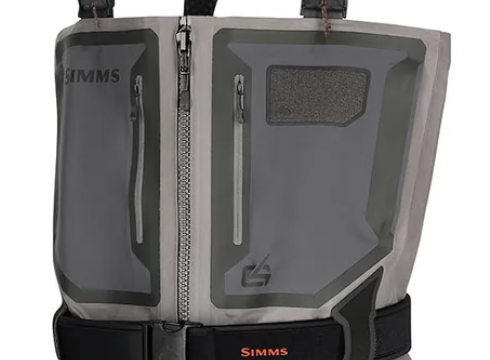
Photo: Courtesy of Simms
The G4Z sports plenty of pockets, even if I wish they were a big larger. It’s hard to design big pockets on a zippered wader, but this is one area where I think Simms could improve.
As it stands, the G4Z features two zippered stretch-woven pockets on the chest of the wader, perfect for storing fly boxes or other terminal tackle. Beneath those pockets are two zippered handwarmer pockets lined with high-pile fleece. The higher pile fleece dries your hands quicker, and the fleece itself dries faster after it gets wet.
What truly stands out here, however, is that the interior pockets are completely waterproof. This is the first time Simms has built a fully-waterproof interior pocket into a wader.
Finally, it’s important to note that the pockets are welded on, instead of stitched. Simms made it a point to reduce stitching and seams as much as possible with the G4Z, which ultimately results in a more streamlined, flexible wader.
Suspenders
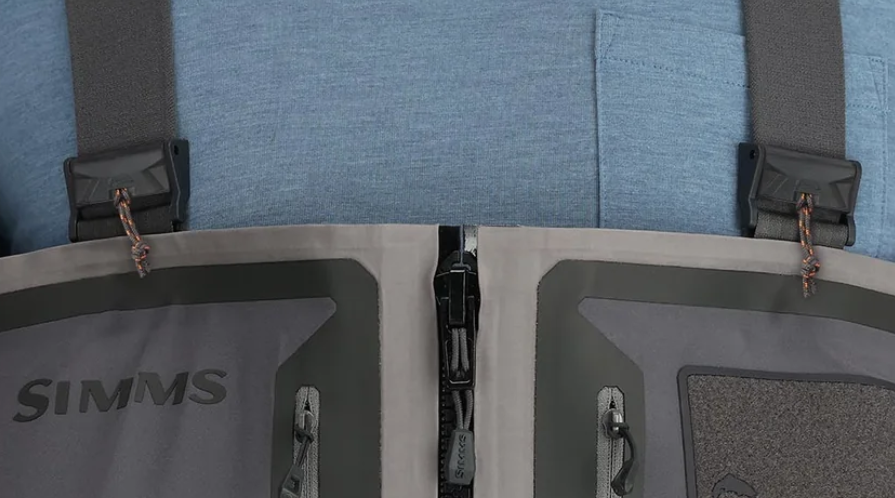
Photo: Courtesy of Simms
There’s not much anyone can to do revolutionize suspenders, but Simms made a few important changes for the G4Z. First is the inclusion of quick-adjust cam-lock hardware to, well, quickly adjust the suspenders. It’s by far the easiest suspender adjustment system I’ve ever used.
You flip up the cam lock and open the zippered handwarmer pocket to pull down on the suspenders to adjust them to the perfect height. Then, snap the cam lock back in place and you’re done. It’s easy to adjust on the water, so if you shed or add layers throughout the day you don’t have to worry about your waders bunching up or being too loose.
Weight
Weight often isn’t a consideration when buying waders, but the G4Z is significant in that regard because these waders clock in at 49.76 ounces. The G3 Guide waders are 49.36 ounces.
Even with the addition of a waterproof zipper, the G4Z wader is barely heavier than the G3 Guide waders. It’s remarkable just how light and comfortable the G4Zs are.
Neoprene Booties
I want it on the record that I hate the word “booties.”
With that out of the way, I do want to look at the new neoprene booties Simms utilizes on the G4Z. These feature a new compression-molded shape that Simms claims will aid the booties in sliding in and out of wading boots, improve boot fit, and improve lace bite.
I did notice that these neoprene booties slide in and out of my wading boots with less trouble than other waders I use (for context, I wear Korkers River Ops BOA boots). Whether they provide better fit or lace bite, I’m not entirely sure. Based on the shape of the booties, though, I think they keep you from overtightening laces, which is one of the biggest factors in getting cold feet, especially during winter fly fishing. Regardless, I applaud Simms for trying something new and different on a part of the wader most of us never think about.
Final Word
I want to start this section with one last thing that Frazier told me about the G4Zs: “The big thing that I put forth with this wader is that there are significant changes aesthetically, but a lot of the performative advantages are subtle details. The fit, things like that. To me, it’s the new suspender harness, the cam locking hardware, but then there’s a lot of subtleties that really add up.”
After almost four months with the G4Zs, that’s my impression as well. The changes in this wader are subtle, but they add up to create what is the best Simms wader I’ve ever used.
My only real knock on these is that I’d like bigger front pockets and a longer wading belt. This belt feels a bit too short, but in fairness to Simms, I’m fat, so that might be my problem.
The cam-locking suspenders are a great feature. I like these just as much as I love the magnetic suspenders on the Skwala Backeddy wader.
What stands out the most, however, is the fit and function of the G4Z compared to my old G4s. It’s clear Simms spent time creating a wader that better moves with anglers while on the water, giving us a greater range of motion.
I haven’t abused these waders over the last four months, but I haven’t been easy on them, either. They’ve held up to boulder scrambling, a few long hikes, and falling on sharp rocks a few times, and don’t look any worse for the wear. Given that Simms used the same 4-layer fabric package they’ve been using since 2019, I’m not concerned about the long-term durability of the G4Zs.
The price is certainly a sticking point, but before you carry your torches and pitchforks to Bozeman, consider that, in 2008, the first G4 wader sold for $700. Adjusted for inflation, that’s $1,002.74 in 2024. We’ve always paid a premium for the best gear on the market, and that’s what the G4Z is—the best Simms wader currently available.









